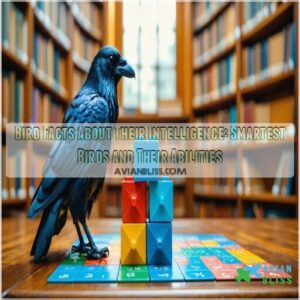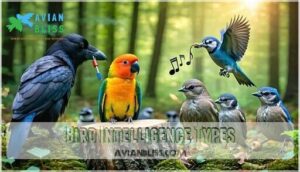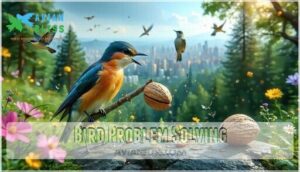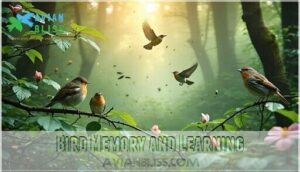This site is supported by our readers. We may earn a commission, at no cost to you, if you purchase through links.

Crows and ravens solve puzzles that’d stump most pets, even crafting tools to get food.
African grey parrots? These chatterboxes can mimic words, count, and understand abstract concepts like "zero."
Then you’ve got cockatoos showing off their musical rhythm—yes, they can dance!
Social smarts? Great-tailed grackles know how to charm their way up the pecking order, while jackdaws coordinate in groups like feathered diplomats.
Their brains, small but packed with neurons, rival some primates in efficiency, making birds not just smart—they rewrite what we think intelligence looks like in the animal world, with their ability to be extraordinary.
Table Of Contents
- Key Takeaways
- Bird Intelligence Types
- Avian Brain Structure
- Bird Problem Solving
- Bird Memory and Learning
- Bird Social Intelligence
- Frequently Asked Questions (FAQs)
- What intelligence do birds have?
- Which bird has the highest IQ?
- What bird has the IQ of a 7 year old?
- What is the most emotionally intelligent bird?
- Are birds intelligent?
- Which birds are most intelligent?
- How do you know if a bird is intelligent?
- Are pigeons intelligent birds?
- What are smart facts about birds?
- What is the most genius bird?
- Conclusion
Key Takeaways
- You’d be amazed how birds like crows and ravens craft tools, solve puzzles, and adapt to urban challenges, showcasing exceptional problem-solving skills.
- Parrots, especially African greys, don’t just mimic words—they understand abstract concepts like “zero” and display reasoning like a 7-year-old.
- Cockatoos groove to music and create rhythmic beats with sticks, proving birds can excel in creativity and musical intelligence.
- Birds have impressive memory and social smarts, with species like jackdaws navigating group dynamics and corvids recalling cache locations for months.
Bird Intelligence Types
You’ll be amazed at how bird intelligence comes in many forms, from problem-solving to musical aptitude.
Each species showcases unique skills—proving that brains, not just wings, truly help them soar.
Ravens and Crows Problem Solving
Ravens and crows, part of the clever crow family, are fascinating tool-using birds known for innovation and adaptability.
Ravens and crows amaze with tool use, showcasing innovation, adaptability, and intelligence that rivals young human minds.
They demonstrate corvid intelligence through cognitive mapping, mastering tools like hooks for food retrieval.
They even ace challenges like the Krushinsky test, and urban adaptation and error correction highlight their sharpness, showing animal problem-solving rivals that of a seven-year-old child.
Further exploration of their cognitive abilities and products can reveal more about their impressive intelligence.
African Grey Parrots Speech Abilities
From cracking puzzles to cracking jokes, birds impress.
Cracking puzzles and cracking jokes, birds dazzle with wit, proving intelligence takes flight in the animal kingdom.
African Grey Parrots stand out with their speech abilities.
Remember Alex? His vocabulary amazed scientists, proving parrot intelligence rivals 5-year-olds!
Watch out, humans—parrot communication isn’t just mimicry; it shows understanding.
Here’s why they’re “speak-easy” geniuses:
- Mimicry vs. Understanding
- Concept Grasping
- Cognitive Parallels
- Language Acquisition
- Ethical Implications
Their ability to grasp complex concepts relies on advanced cognitive skills.
This showcases their cognitive skills, speech abilities, mimicry, and language acquisition capabilities.
Cockatoos Musical Intelligence
Cockatoos, masters of musical mimicry, create rhythmic beats using sticks they fashion themselves—how’s that for avian creativity?
Their rhythm perception and dance coordination, paired with vocal learning, showcase dazzling parrot intelligence. Each male demonstrates unique emotional expression through personalized beats, resembling drum solos in nature.
Notably, this behavior is a form of cockatoo musical behavior used during courtship.
Trait Example Significance
Great-Tailed Grackles Social Intelligence
The Great-Tailed Grackle’s social intelligence is impressive, showing off their knack for adapting and thriving alongside humans.
These clever birds excel at:
- Grackle Social Hierarchy: Traversing complex group dynamics.
- Grackle Communication Skills: Sharing warnings and opportunities.
- Grackle Cooperative Breeding: Supporting each other in raising young.
- Grackle Urban Adaptation: Using cities ingeniously for survival.
- Grackle Innovation Learning: Solving problems with creativity.
Bird behavior at its smartest!
Avian Brain Structure
Bird brains might be small, but they pack a surprising punch, with structures allowing advanced problem-solving and memory.
Unlike mammals, birds lack a cerebral cortex, yet their unique brain organization proves size isn’t everything in regards to intelligence.
Brain Size and Body Size Relation
You might think larger birds dominate brainpower, but relative brain size matters more.
Birds pack impressive neuron density into tiny spaces, boosting cognitive capacity. Imagine fitting a high-performance computer in a shoebox!
Some smaller birds outthink larger ones due to brain evolution and size thresholds. Here’s a comparison:
| Species | Average Weight | Brain Size (g) | Relative Brainpower |
|---|---|---|---|
| Crow | 500 g | 9.8 g | High |
| Parrot | 450 g | 15 g | Very High |
| Ostrich | 104 kg | 42 g | Low |
| Pigeon | 300 g | 5.5 g | Medium |
Cognitive Abilities Comparison
Bird brains may be small, but they’re powerhouses of cognitive abilities, often rivaling mammals.
By comparing avian vs. mammalian intelligence, you’ll notice:
- Corvids outperform parrots in problem-solving.
- Parrots excel with vocal vocabulary size and reasoning.
- Birds’ brain cell count packs efficiency.
- Cognitive testing reveals species comparison insights, reshaping ethical considerations toward animal intelligence.
Birds prove brains beat brawn!
Mammal Brain Structure Differences
While discussing brain capabilities, bird intelligence stands out despite structural differences with mammalian brains.
Avian brains lack a cortex but boast high neuron density and specialized brain regions.
This parallel evolution highlights unique cognitive implications.
| Feature | Birds | Mammals |
|---|---|---|
| Cortex Presence | Absent | Present |
| Neuron Density | High | Varies |
| Cognitive Flexibility | Remarkable | Advanced |
| Brain Regions Usage | Highly specialized | Generalized |
| Evolution | Parallel adaptations | Diverse pathways |
Bird Problem Solving
You’d be amazed at how birds solve problems using tools, memory, and keen observation.
From cracking nuts with cars to crafting complex tools, their creativity rivals that of some mammals.
Tool Use and Creation Examples
In the context of tool use, birds amaze with their creativity.
Caledonian crows, like Betty, craft tools from grass stems. Kea parrots dismantle objects, turning chaos into discovery. Their highway nutcrackers? Crows dropping nuts under cars—pure genius.
- Crow Toolmaking: Fashioning tools instinctively.
- Object Manipulation: Kea parrots taking apart puzzles.
- Avian Innovation: Using cars to crack open snacks.
Birds also demonstrate diverse feeding strategies to acquire resources.
Advanced Problem Solving Abilities
Some tool-using birds, like crows and cockatoos, shine in solving complex tasks with cognitive flexibility.
Their problem-solving strategies include crafting tools and applying innovative solutions to challenges.
For example, crows fashion hooks from twigs, showcasing impressive bird problem-solving skills.
This tool use evolution demonstrates remarkable bird intelligence, proving animals can adapt to intricate puzzles—turning basic objects into tools for survival, and showcasing remarkable bird intelligence.
Adaptation to Environmental Changes
When climate change throws curveballs, birds don’t flinch—they adapt.
Behavioral adaptability helps them thrive:
- Migration Shifts: Some species adjust routes or skip migration entirely.
- Urban Environments: Cleverly using cities, like magpies repurposing anti-bird spikes for nests.
- Nesting Adaptations: Shaping homes to beat predators or weather extremes.
- Survival Strategies: Innovatively exploiting human-made resources to secure food and shelter.
Bird Memory and Learning
You might be surprised to learn that many birds have extraordinary memories, capable of storing detailed information for months.
From recalling thousands of food cache locations to tracking nectar availability, their learning abilities rival those of some mammals.
Excellent Memory for Food Caching
Birds like corvids possess incredible spatial memory, letting them store food in hundreds of caches and recall locations months later.
This seasonal recall supports food security during scarcity. Notably, forgetting mechanisms help avoid outdated caches.
Their exceptional cache retrieval beats scientist-planted seeds, showcasing advanced animal memory and strategy. Such bird memory proves their brains punch well above their weight!
Corvids’ behavior includes sophisticated food storing for later consumption.
Mental Maps and Navigation
Think about crows recognizing thousands of landmarks while traversing their territories. That’s spatial memory in action!
Birds like swans and geese use magnetic sense for migration patterns, blending bird cognitive abilities with natural GPS. Route planning isn’t random; avian intelligence forms detailed mental maps.
Birds also use Earth’s magnetic field to orient themselves. It’s astonishing how bird memory powers their precision during journeys that’d baffle most humans.
Nectar Replenishment Time Learning
Ever notice how some birds seem to have a mental alarm clock?
Hummingbirds excel at nectar replenishment time learning, using temporal memory to track when flowers refill.
This boosts foraging efficiency and demonstrates floral resourcefulness.
Their pollination strategies reflect remarkable avian intelligence.
It’s like nature’s version of a free refill policy—a perfect showcase of bird cognitive abilities and animal learning.
Bird Social Intelligence
You’d be surprised how socially savvy birds can be, forming complex relationships and even working together to solve problems.
From cooperative hunting to outsmarting rivals, their social intelligence rivals that of many mammals, showcasing their ability to form complex relationships.
Cooperation and Social Interaction
You’ve seen how memory helps birds navigate life’s challenges. Now, let’s explore their teamwork.
Flock dynamics reveal incredible social learning. Birds share survival tips and coordinate through complex communication signals. Examples like cooperative breeding show altruistic behavior in action.
Understanding dominance hierarchy at feeders can further illuminate these complex interactions.
Here’s why bird social behavior is fascinating:
- Problem-solving as a team.
- Coordinated predator defense.
- Teaching younger flock members.
Emperor Penguins and Jackdaws Cooperation
Despite their impressive cognitive abilities, Penguin Cooperation and Jackdaw Socializing are geographically impossible given their distant habitats.
Emperor Penguins thrive in Antarctica, while Jackdaws inhabit Eurasia.
Their adaptability showcases animal intelligence in distinct ways, reflecting unique solutions and specialization.
| Feature | Emperor Penguins | Jackdaws |
|---|---|---|
| Region | Antarctica | Eurasia/North Africa |
| Group Problem-Solving | Shared Defense | Cooperative Breeding |
| Cognitive Abilities | Survival Challenges | Social Problem-Solving |
These problem-solving birds reflect unique solutions, showcasing bird brains’ adaptability and ability to find specialized ways to survive.
Emperor penguins rely on coordinated huddling behavior to conserve energy during harsh Antarctic winters, demonstrating their intelligence in action.
Deception and Intelligence in Birds
Clever birds like ravens excel in avian deception tactics, including mimicry and deceit.
These “bird brain” masterminds use social manipulation, such as deceptive signaling to mislead competitors or predators.
Evolutionary advantages drive such strategies, showcasing bird intelligence.
Problemsolving birds like jays hide food in plain sight, tricking rivals.
These behaviors highlight animal intelligence that’s both resourceful and surprisingly strategic.
To further enhance their skills, consider raven training tools available.
Frequently Asked Questions (FAQs)
What intelligence do birds have?
Birds are surprisingly smart, showcasing problem-solving, tool use, memory, and planning.
Parrots and crows even rival some mammals in intelligence, proving brain size doesn’t determine wit.
They adapt creatively, solving challenges like true nature-born innovators.
Which bird has the highest IQ?
You might think it’s hard to measure bird intelligence, but crows and parrots top the charts.
Crows solve puzzles, use tools expertly, and plan ahead, while parrots display impressive reasoning and even understand abstract concepts, showcasing their intelligence.
What bird has the IQ of a 7 year old?
Parrots, especially African greys, can rival the cognitive abilities of a 7-year-old child.
They recognize shapes, numbers, and colors, even grasp abstract concepts like “none,” showing reasoning and memory that’d amaze anyone!
What is the most emotionally intelligent bird?
Parrots, especially African greys, showcase incredible emotional intelligence.
They recognize emotions, mimic human speech, and form lasting bonds.
Like a feathery therapist, they sense your mood and respond, making them the emotional geniuses of the bird world.
Are birds intelligent?
In the grand scheme of things, birds are surprisingly brilliant.
They solve problems, use tools, and even share knowledge within flocks.
From crafting tools to mimicking speech, their smarts rival many mammals—pretty impressive for "bird brains"!
Which birds are most intelligent?
Crows, ravens, and parrots top the avian IQ chart.
They solve puzzles, use tools, and even plan for the future.
Think of them as the bird world’s Einsteins—brilliant, curious, and always a step ahead.
How do you know if a bird is intelligent?
You can spot an intelligent bird by observing tool use, problem-solving, or memory skills.
Look for behaviors like solving puzzles, mimicking sounds, or adapting to challenges—these traits highlight their clever, creative thinking.
Are pigeons intelligent birds?
As the saying goes, "don’t judge a book by its cover."
Pigeons, with remarkable memory and problem-solving skills, can recognize faces, navigate complex routes, and even distinguish words—a surprising level of intellect for such humble birds, showcasing their problem-solving abilities.
What are smart facts about birds?
Some craft tools, like crows shaping sticks to grab food.
Parrots use logic in puzzles, memorize words, and mimic speech.
Even pigeons recognize patterns and solve problems, proving brains aren’t always about size.
What is the most genius bird?
It’s funny how nature surprises us—parrots and crows compete for the genius title.
Crows craft tools and plan ahead, while parrots mimic speech, solve puzzles, and grasp concepts.
Both prove brain size isn’t everything.
Conclusion
Did you know that some bird species have neuron-packed brains with densities rivaling primates?
From crows crafting tools to African grey parrots mastering abstract concepts, avian intelligence constantly surprises us.
Whether it’s cockatoos grooving to music or jackdaws coordinating like diplomats, birds showcase an impressive range of capabilities.
Their problem-solving skills, memory, and social savvy redefine intelligence in nature.
Learning these bird facts about their intelligence highlights how much there’s to admire in our feathered friends.
- https://en.wikipedia.org/wiki/History_of_the_center_of_the_Universe
- https://www.pnas.org/doi/10.1073/pnas.2121467120
- https://www.theguardian.com/science/2023/jul/11/crows-and-magpies-show-their-metal-by-using-anti-bird-spikes-to-build-nests
- https://linkinghub.elsevier.com/retrieve/pii/S1364661323002814
- https://dx.doi.org/10.1016/j.tics.2023.11.002








